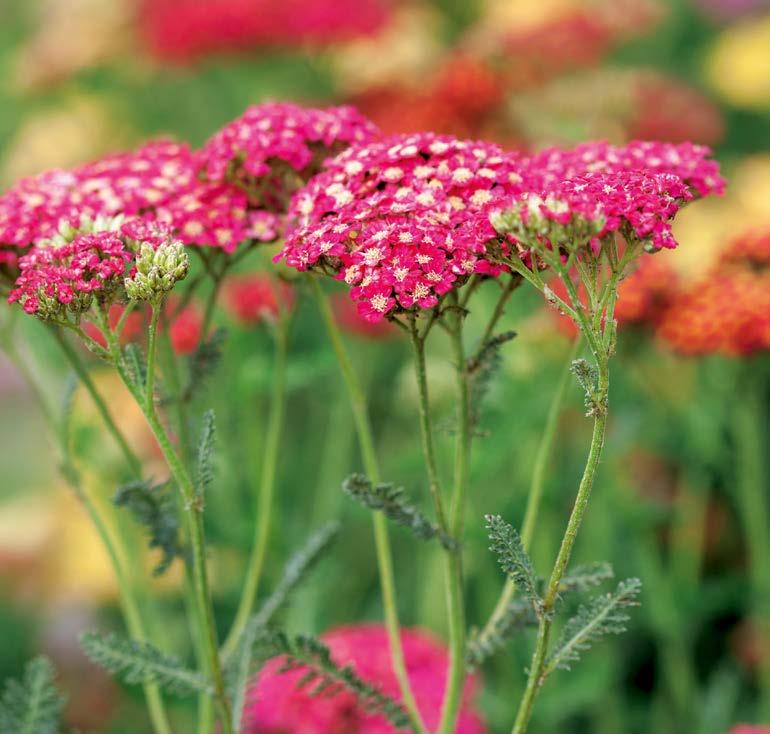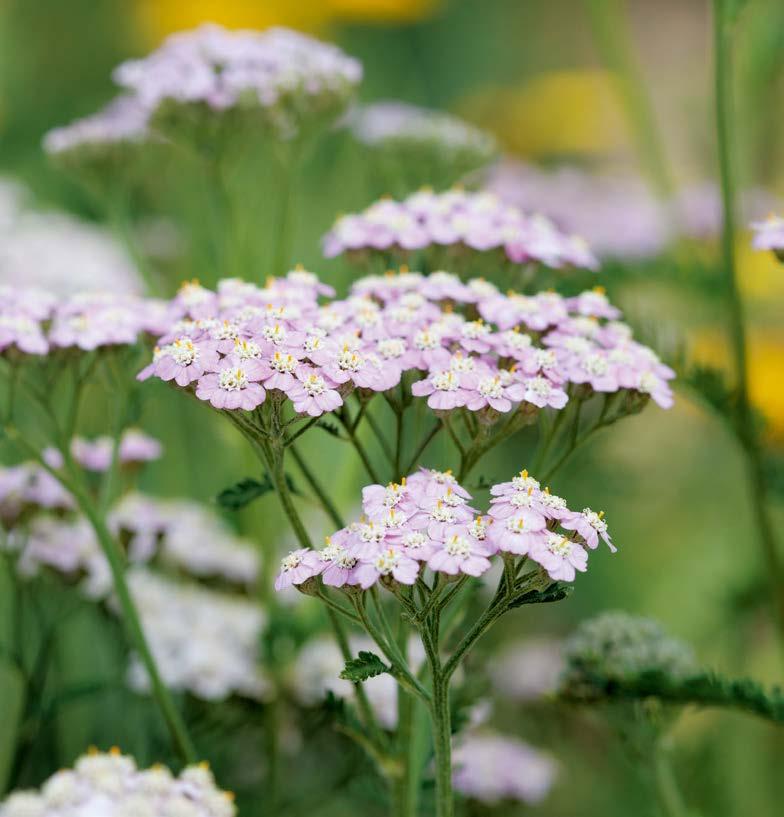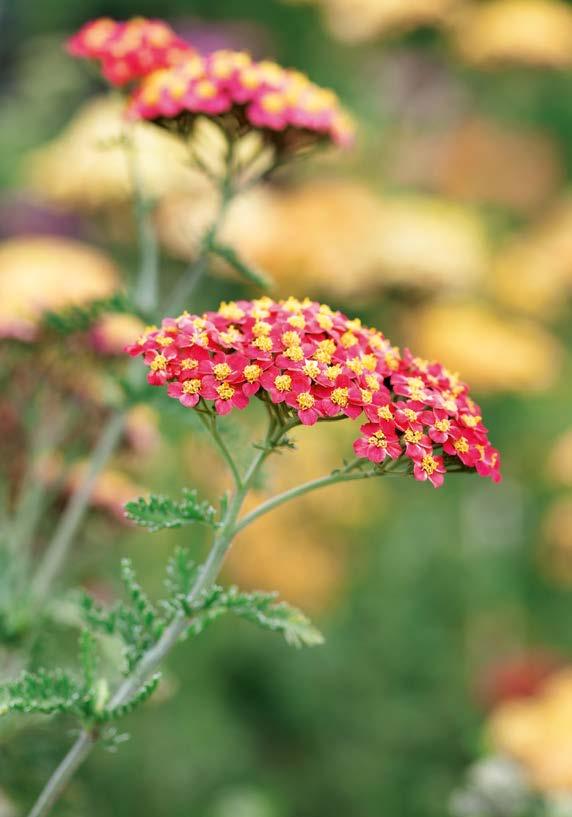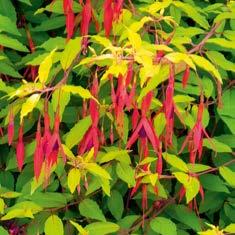
15 minute read
Plant Focus Achilleas are a sensible
One of the keys to creating interesting planting combinations is the use of contrasting flower shapes and structures. This is why the flat-topped flowers of achilleas have become such a go-to plant for designers, providing a foil to the spires and spheres of other summer-flowering perennials.
Not that this is the only attraction of these plants. “I love them for their colour variation – whether it’s bold pops of colour or pastel tones from ivorywhite and shades of yellow and orange to a range of pinks and the deepest shades of red,” explains John Cullen, who is the custodian of a National Collection of Achillea millefolium at his nursery in Lincolnshire. “They have a long flowering season, with some starting to bloom in April – in some years we’ll still have achilleas in flower in December. They also score highly when it comes to attracting wildlife, which has always been a key feature of the plants we grow at the nursery,” adds John. The larvae of several moths feed on achilleas, starlings line their nests with the leaves, and the flowers are a great source of pollen and nectar for pollinators – especially butterflies and short-tongued bees. John took on the National Collection in 2017 after meeting a representative from Plant Heritage at a plant show. “They had earmarked about 20 or so different genera of plants that they wanted to protect, and while I was interested I didn’t want to move away from the nursery’s focus on plants for pollinators.” Serendipitously, beefriendly achilleas were one of the plants on Plant Heritage’s list. “This also coincided with us moving our nursery and lots of shade-loving plants from London to a site in Lincolnshire where there was no shade! Sun-loving achilleas seemed the perfect fit.” Achilleas are native to the northern hemisphere and they have a plethora of common names, which is always a sign that a plant has a long history. Yarrow is the most common, with some of the others including stench grass, old man’s pepper and soldier’s woundwort. This last name refers to the Ancient Greek mythological warrior Achilles, who is said to have treated his wounded soldiers with yarrow because it had known healing properties – a legend that led 18th-century Swedish botanist Carl Linnaeus to name the plant achillea.
They’re a member of the daisy family, with flowerheads made up of individual blooms each with both disc and ray florets that are held on different length stems so that they form flat-topped flower clusters. In the UK the wildflower A. millefolium has white, occasionally pink, flowers and grows in meadows, hedgerows and on scrubby ground, and it’s from this and other wild species that plant breeders have managed to create such a wide array of colourful garden-worthy plants.
They range in height from 20cm up to 2m and have upright, slender stems and airy, open flower clusters that give these herbaceous perennials an
Above Golden Achillea filipendulina ‘Parker’s Variety’ glows when grown in combination with delicate, purple Verbena hastata.

Top Achillea ptarmica ‘Peter Cottontail’ has button-like flowers. Right The pink-red flowers of ‘Fanal’ fade to brick-red then yellow. This image ‘King Alfred’ is low-growing, so good for the front of borders.



Former winner of ‘HHA/Christies Garden of the Year’ Award Former GARDEN SCHOOL COURSES STABLEYARD CAFE 30th March – 29th September Daily Tuesday to Saturday and Bank Holiday Weekends 12 noon - 5.30pm winner of ‘HHA/Christies Garden of the Year’ Award Nr Guilsborough Northamptonshire NN6 8RQ COTON MANOR GARDEN Nr Guilsborough Tel: 01604 740219 www.cotonmanor.co.uk EXTENSIVELY PLANTED Northamptonshire NN6 8RQ Tel: 01604 740219 H A L L & G A R D E N S 10 ACRE GARDEN SET IN www.cotonmanor.co.uk
BEAUTIFUL COUNTRYSIDEEXTENSIVELY PLANTED 10 ACRE GARDEN SET IN BEAUTIFUL COUNTRYSIDE PLANT NURSERY GARDEN SCHOOL COURSES PLANT NURSERY GARDEN SCHOOL COURSES STABLEYARD CAFE STABLEYARD CAFE


30th March – 29th September Daily Tuesday to Saturday and Bank Holiday Weekends 12 noon - 5.30pmFormer winner of ‘HHA/Christies Garden of the Year’ Award 30th March – 29th September Daily Tuesday to Saturday and Bank Holiday Weekends 12 noon - 5.30pm COTON MANOR GARDEN Nr Guilsborough Northamptonshire NN6 8RQ Tel: 01604 740219 www.cotonmanor.co.uk EXTENSIVELY PLANTED 10 ACRE GARDEN SET IN BEAUTIFUL COUNTRYSIDE PLANT NURSERY GARDEN SCHOOL COURSES STABLEYARD CAFE 30th March – 29th September Daily Tuesday to Saturday and Bank Holiday Weekends 12 noon - 5.30pm Gardens only open from Bank Holiday Monday 3 May 2021 Hall & Gardens open from Thursday 1 July 2021 Cottesbrooke is a wonderful Queen Anne house dating from 1702 and set in delightful award winning gardens in rural Northamptonshire. The formal gardens are continually being updated and developed. The Wild Garden, a short walk across the Park, is laid out along the course of a stream and provides a romantic setting for acers, gunneras and Spring flowers. The remarkable 18th century landscaping of the Park, its vistas and lakes, provide the backdrop to the Hall. Old Laundry Tearoom remains closed until further notice Free parking / No dogs except to assist / Toilets Limited wheelchair access, please call in advance Please visit our website for the latest information & updates www.cottesbrooke.co.uk 01604 505 808 cottesbrooke cottesbrooke.estate ll ll ll Long established as the leader in all matters horticultural and based at the historic Chelsea Physic Garden ONE YEAR GOOD GARDENING DIPLOMA BOOKING NOWBOOK NOW FOR SEPTEMBER 2015
nSeptember 2021 – June 2022 n Covers the best in planting design while training in the more serious aspects of horticultural techniques. Practical sessions held at Arundel Castle under the guidance of head gardener Martin Duncan and at Sandhill Farm House, Rogate. Lectures by many leading gardening personalities and regular visits to outstanding private gardens. Students also learn to draw up planting plans. (1 day a week (Tues), 10.30am–3.15pm, over three terms) THE ESSENTIAL GARDEN DESIGN DIPLOMA BOOKING NOW DIPLOMA COURSES One Year Good Gardening Diploma – A Planting Design Course September 2015 – June 2016 Covers the best in planting design while training in the more serious aspects of horticultural techniques (1 day a week (Tues), 10am–3.15pm, over three 10 week terms).
January-March 2022 10 WEEK INTENSIVE GARDEN DESIGN DIPLOMA
Based at the Chelsea Physic Garden and led by Rosemary Alexander and architect Catriona Rowbotham, the course January – March 2016 is an overview of Garden Design, covering all the elements needed to rethink an average garden. Taking students step Covers all you need to know in this diverse subject, including by step through site surveying, using the grid, horizontal and vertical features, garden layouts and planting plans, costing TWO real design projects and CAD tuition. (3 days a week in school, and specification, plus drawing tuition and homework on design and plant portfolios. Tutors are well respected in the 10am-3.15pm, plus 2 days homework) industry and will guide students on how to succeed in this diverse profession. (2 days a week (Wed & Thur) 10.30am-3.15pm, plus 2 days homework) GARDEN MAKERS DAY GARDENING FOR BEGINNERS BOOK FOR 2022October 2015
Wednesday & Thursday 21/22 April and 5/6 May 2021 One of our most popular courses, led by master horticulturalist Ben Pope, which aims to take each student through all Distance Learning Courses - study anytime, anywhere in the world. the practical elements of caring for a garden from soil, tools, maintenance, seed sowing and propagating, weed control 1-3 years to complete. and pests and diseases. The first 3 days will be spent at the Chelsea Physic Garden and the final day will be spent gaining practical experience in Rosemary Alexander’s much praised garden near Petersfield and the garden nearby, where Ben is GARDEN DESIGN & CARING FOR YOUR GARDEN in charge. Participants will be given a chance to prune, plant, sow seeds and regular maintenance tasks will be discussed. A step by step guide to designing your own garden: drawing up A light lunch and refreshments will be provided daily. plans, hard landscaping, site analysis, planting etc. Taught through GARDEN DESIGN & CARING FOR YOUR GARDEN a comprehensive course book, with projects submitted by post.
Garden of Medicinal Plants – Chelsea Physic Garden Photo: R Alexander
Not sure which Diploma course is for you? Garden of Rosemary Alexander, Principal EGS © Marianne Majerus We prefer potential students to attend an Sandhill Farmhouse, Hampshire Information Session when Rosemary explains the whole course content and you can see our facilities Not sure which course is for you? Come along to an Information Session to fi nd out more. at the historic Chelsea Physic Garden. JUST CONTACT US TO SET UP A DATE/TIME For full details, dates, prices visit our website
www.englishgardeningschool.co.uk www.englishgardeningschool.co.uk Email: info@englishgardeningschool.co.uk Email: info@englishgardeningschool.co.uk Tel: 020 7352 4347 Tel: 020 7352 4347

Distance Learning Courses study anytime, anywhere in the world
A stepping stone to a new career. These two correspondence courses are a step by step guide to either designing your own garden or learning how to plant and maintain an existing garden: drawing up plans, hard landscaping, site analysis, planting, month by month tasks etc. Taught through a comprehensive course book, with projects submitted to us. The English Gardening School_B634393_2mg.indd 1 1-3 years to complete and individual assessment.
Long established as the leader in all design and gardening tuition and based at the unique and historic Chelsea Physic Garden




architectural quality that means they work equally well in traditional cottage garden planting schemes or in modern prairie-style borders with ornamental grasses. The foliage is attractive too, delicate and feathery with a fern-like appearance in mid- or silvery-green. John plants achilleas with verbenas and salvias such as ‘Amistad’, which provide the purple element missing from the achillea colour range while enjoying the same growing conditions.
A. ptarmica ‘The Pearl’, also known as sneezewort, was a favourite of Gertrude Jekyll’s, and produces sprays of small, double, button-like, pure white flowers amid dark green foliage; ‘Perry’s White’ and ‘Peter Cottontail’ are similar, with all three creating a gypsophila-like froth. For single white flowers, try A. millefolium ‘White Beauty’, a selection of our native wildflower.
The glowing golden flowerheads of the tallest achilleas, A. filipendulina ‘Parker’s Variety’, ‘Gold Plate’ and ‘Cloth of Gold’, reach up to 1.5m and more. For lemony-yellow blooms there are cultivars such as ‘Credo’ and ‘Taygetea’. Copper colours and apricot shades, meanwhile, are represented by the cultivars ‘Terracotta’; ‘Fanal’, which starts off red before fading to orangey-yellow; ‘Walther Funcke’; and the fiery shades of ‘Feuerland’. ‘Apricot Delight’ from the Tutti Frutti Series is a relatively recent introduction, bred to be compact with a bushy habit, growing to a height of 60cm with a spread of 50cm and has flowers in fruity tones of red, pink and orange, all on the same plant at any one time.
Shades of pink include ‘Lansdorferglut’, ‘Cerise Queen’ and the fabulously named ‘Forncett Fletton’, which sounds like a character from an American soap opera and has fetching salmon-pink blooms. The flowers of ‘Lilac Beauty’ emerge a deep rosepink colour before fading to a pretty lavender.
For jewel-like ruby shades there’s ‘New Vintage Red’, ‘Red Velvet’ and ‘Pomegranate’, which is John’s favourite. “It’s very floriferous with a fantastic rich colour and, unlike some achilleas, it doesn’t tend to bleach in strong sunshine.” This chameleonlike colour change that some achilleas exhibit can be an attractive trait, particularly when several colours appear on a plant at the same time, but John suggests it’s worth taking this into consideration if you have a strong colour theme running through your borders. For Top ‘Apricot Delight’, instance, ‘Paprika’ from the recently starts off with deep red introduced ‘Tutti Frutti’ flowers that change to series of compact plants. Middle ‘Terracotta’ bears pale pink and finally copper-orange flowers. a creamy-yellow. Bottom Vibrant Achillea John also millefolium ‘Cerise recommends the new Queen’ catches the eye. Far left Tall Achillea Seduction Series, which filipendulina ‘Gold Plate’ have been bred to be can reach 1.5m. shorter, so they’re less
Above left ‘Lilac Beauty’ likely to flop and are fades from deep pink very floriferous. “For to palest lavender. Above right ‘Paprika’ containers I’d suggest starts off with deep-red ‘Moondust’ which flowers before they age is a very pale yellow to creamy yellow. and about 20cm tall, and pink ‘Little Susie’, which grows to about 40cm. Use a John Innes No2 compost mixed 50:50 with grit for good drainage.” Others include canary-yellow ‘Little Moonshine’ and ‘Pink Grapefruit’, as well as ‘King Alfred’, which is very low-growing, making it a good choice for the edge of borders, rock gardens and pots.
Achilleas also make long-lasting cut flowers and can be used in both fresh and dry flower arrangements. In either case, cut them when the flowers are showing colour but not fully open, as they’ll continue to emerge once picked. To dry the flowers, bunch several stems together and tie with twine then hang them upside down somewhere warm, dry and dark for two to three weeks.
Find space for these easy-to-grow perennials and not only will they bring a splash of joyful colour to your garden, they’ll also create a space that buzzes and flutters with bees and butterflies. n

John Cullen Gardens, Eagle Lodge, Archers Lane, Algarkirk, Boston PE20 2AG. The nursery opens by appointment with the best time to view the achillea collection being midsummer. Tel: 01205 460567; johncullengardens.com

GROWING ADVICE Easy-care achilleas
Achilleas are easy to grow if they’re given the right conditions, advises John Cullen
Plant achilleas in a sunny, open space where they won’t be shaded out by taller plants at the back of a border, otherwise they’ll move towards the light and become floppy.
They’re classified as drought tolerant, but that doesn’t mean you should plant them and leave them. Water them during their first year so they establish well, then you won’t need to fuss over them.
They’ll struggle on heavy clay soil, so incorporate plenty of grit when planting.
Stake the taller varieties and place circular grid-type supports over the top of midheight, clump-forming varieties, which have a tendency to sprawl outwards. They’re classed as short-lived perennials so divide every three years in late winter or early spring, discarding the woody centre and replanting the younger, outside growth to reinvigorate the plants. Aphids can be a problem but ladybirds on our nursery keep them under control. Slugs will go for the young foliage as it emerges in spring, but once achilleas leaf up they’re less attractive to them. Deadhead by cutting the spent flower stem right back to the base of the plant to encourage it to send up new shoots.



Tiny Dancer
The slender, elegant blooms of Fuchsia magellanica are in a different class to the big, blowsy hybrids
Fuchsias can be a divisive plant: some gardeners love them, others really don’t – particularly when it comes to those hybrids with the over-the-top, slightly chubby, ballerina-tutu flowers. Yet there is one fuchsia that can often persuade the doubters: Fuchsia magellanica. Its flowers are slender, elegant, graceful. In a world of Mavis Cruets, Fuchsia magellanica is Margot Fonteyn.
For all its graceful flowers, however, this fuchsia could also be considered a thug. It stole another fuchsia’s identity for the best part of 100 years, although really that was the fault of the botanists who mistook it for Fuchsia coccinea. The real F. coccinea languished in Oxford Botanic Garden until botanists realised they were two distinct species; in the meantime F. magellanica had “spread to every garden in the Kingdom”, Joseph Hooker wrote.
It’s an invasive plant in other parts of the world too, smothering native flora in Australia and Réunion Island in the Indian Ocean. Thankfully in our climate it isn’t problematic, and if you visit south-west Ireland in early summer, when the hedgerows drip with its pendent burgundy-pink blooms, it’s hard not to be charmed.
The species name comes from the Strait of Magellan, which was where French naturalist Philibert Commerson collected it in December 1767, although it had been discovered earlier by Louis Feuillée, who named it ‘thilco’. Commerson was
HOW TO GROW
Fuchsia magellanica is hardy once it’s established when, even if the top growth is cut back by frost, it will shoot from the base or its woody framework. It will grow well in sun, dappled or full shade and thrives in fertile soil. Mulch the base while it’s establishing. part of Louis-Antoine de Bougainville’s voyage to circumnavigate the globe. His valet was on board with him, but it was later revealed that the valet was actually Jeanne Baret, a woman disguised as a man (and as a result, the first woman to circumnavigate the globe). It’s thought she was Commerson’s mistress, but her presence didn’t distract him from his work: he described the climber bougainvillea, among other plants, during the trip.
Thanks to the mix-ups with F. coccinea, there’s little hard evidence for F. magellanica being grown in the UK before the 1820s, but this beautiful Chilean native has certainly not looked back. n
Fuchsia magellanica: Four interesting varieties for flowers and foliage




F. magellanica ‘Lady Bacon’ Striking flowers with a purple corolla on 1.5m tall shrubs.
F. magellanica ‘Aurea’ This golden-leaved variety reaches between 1.2m and 1.5m tall.
F. magellanica var. gracilis ‘Versicolor’ Pink and cream variegated foliage sets this fuchsia apart.
F. magellanica var. molinae A white-flowered version, with the palest mauve corolla.










